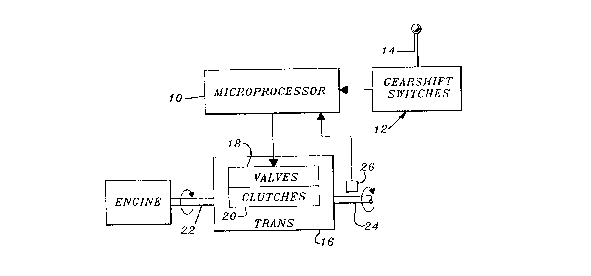Une partie des informations de ce site Web a été fournie par des sources externes. Le gouvernement du Canada n'assume aucune responsabilité concernant la précision, l'actualité ou la fiabilité des informations fournies par les sources externes. Les utilisateurs qui désirent employer cette information devraient consulter directement la source des informations. Le contenu fourni par les sources externes n'est pas assujetti aux exigences sur les langues officielles, la protection des renseignements personnels et l'accessibilité.
L'apparition de différences dans le texte et l'image des Revendications et de l'Abrégé dépend du moment auquel le document est publié. Les textes des Revendications et de l'Abrégé sont affichés :
| (12) Brevet: | (11) CA 2113289 |
|---|---|
| (54) Titre français: | METHODE DE DECELERATION POUR TRANSMISSION A INVERSEUR DE MARCHE |
| (54) Titre anglais: | TRANSMISSION SHUTTLE SHIFT DECELERATION METHOD |
| Statut: | Périmé et au-delà du délai pour l’annulation |
| (51) Classification internationale des brevets (CIB): |
|
|---|---|
| (72) Inventeurs : |
|
| (73) Titulaires : |
|
| (71) Demandeurs : |
|
| (74) Agent: | BORDEN LADNER GERVAIS LLP |
| (74) Co-agent: | |
| (45) Délivré: | 1997-12-16 |
| (22) Date de dépôt: | 1994-01-13 |
| (41) Mise à la disponibilité du public: | 1994-07-30 |
| Requête d'examen: | 1994-01-13 |
| Licence disponible: | S.O. |
| Cédé au domaine public: | S.O. |
| (25) Langue des documents déposés: | Anglais |
| Traité de coopération en matière de brevets (PCT): | Non |
|---|
| (30) Données de priorité de la demande: | ||||||
|---|---|---|---|---|---|---|
|
Transmission automatique comportant plusieurs embrayages, dont un ensemble d'embrayages finals ou directionnels. Les embrayages sont commandés par des électrovalves hydrauliques à action directe et par deux électrovalves hydrauliques proportionnelles ou régulatrices de pression. Les valves modulatrices de pression règlent la pression fournie aux valves à action directe associées aux trois embrayages de marche. La décélération du véhicule pendant un changement de vitesse est effectuée par débrayage (dépressurisation) et par augmentation graduelle de la pression sur seulement deux embrayages dans l'ensemble des embrayages finals ou directionnels.
A powershift transmission includes a plurality of
clutches, including a final or directional set of clutches.
The clutches are controlled by electro-hydraulic direct acting
valves and two electro-hydraulic proportional or pressure
modulating valves. The pressure modulating valves modulate
the pressure supplied to the direct acting valves associated
with the three directional clutches. Vehicle deceleration
during a shuttle shift is achieved by releasing
(unpressurizing) all clutches, then gradually pressurizing
only two clutches in the final or directional set.
Note : Les revendications sont présentées dans la langue officielle dans laquelle elles ont été soumises.
Note : Les descriptions sont présentées dans la langue officielle dans laquelle elles ont été soumises.

2024-08-01 : Dans le cadre de la transition vers les Brevets de nouvelle génération (BNG), la base de données sur les brevets canadiens (BDBC) contient désormais un Historique d'événement plus détaillé, qui reproduit le Journal des événements de notre nouvelle solution interne.
Veuillez noter que les événements débutant par « Inactive : » se réfèrent à des événements qui ne sont plus utilisés dans notre nouvelle solution interne.
Pour une meilleure compréhension de l'état de la demande ou brevet qui figure sur cette page, la rubrique Mise en garde , et les descriptions de Brevet , Historique d'événement , Taxes périodiques et Historique des paiements devraient être consultées.
| Description | Date |
|---|---|
| Le délai pour l'annulation est expiré | 2010-01-13 |
| Lettre envoyée | 2009-01-13 |
| Inactive : CIB de MCD | 2006-03-11 |
| Inactive : CIB de MCD | 2006-03-11 |
| Inactive : CIB de MCD | 2006-03-11 |
| Inactive : CIB de MCD | 2006-03-11 |
| Lettre envoyée | 2004-02-06 |
| Accordé par délivrance | 1997-12-16 |
| Inactive : Dem. traitée sur TS dès date d'ent. journal | 1997-10-09 |
| Inactive : Renseign. sur l'état - Complets dès date d'ent. journ. | 1997-10-09 |
| Préoctroi | 1997-07-22 |
| Un avis d'acceptation est envoyé | 1997-02-18 |
| Demande publiée (accessible au public) | 1994-07-30 |
| Toutes les exigences pour l'examen - jugée conforme | 1994-01-13 |
| Exigences pour une requête d'examen - jugée conforme | 1994-01-13 |
Il n'y a pas d'historique d'abandonnement
| Type de taxes | Anniversaire | Échéance | Date payée |
|---|---|---|---|
| Taxe finale - générale | 1997-07-22 | ||
| TM (brevet, 4e anniv.) - générale | 1998-01-20 | 1998-01-12 | |
| TM (brevet, 5e anniv.) - générale | 1999-01-13 | 1999-01-12 | |
| TM (brevet, 6e anniv.) - générale | 2000-01-13 | 2000-01-12 | |
| TM (brevet, 7e anniv.) - générale | 2001-01-15 | 2001-01-12 | |
| TM (brevet, 8e anniv.) - générale | 2002-01-14 | 2002-01-11 | |
| TM (brevet, 9e anniv.) - générale | 2003-01-13 | 2003-01-10 | |
| TM (brevet, 10e anniv.) - générale | 2004-01-13 | 2003-12-22 | |
| TM (brevet, 11e anniv.) - générale | 2005-01-13 | 2004-12-21 | |
| TM (brevet, 12e anniv.) - générale | 2006-01-13 | 2005-12-30 | |
| TM (brevet, 13e anniv.) - générale | 2007-01-15 | 2006-12-20 | |
| TM (brevet, 14e anniv.) - générale | 2008-01-14 | 2007-12-18 |
Les titulaires actuels et antérieures au dossier sont affichés en ordre alphabétique.
| Titulaires actuels au dossier |
|---|
| DEERE & COMPANY |
| Titulaires antérieures au dossier |
|---|
| KEVIN LEE VAUGHTERS |